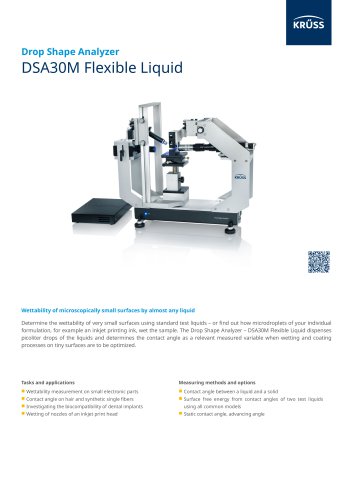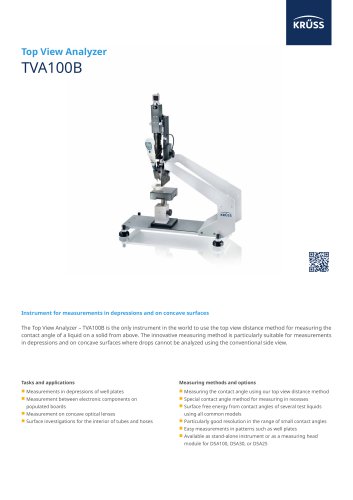 Website:
KRÜSS GmbH
Website:
KRÜSS GmbH
Group: Krüss
Catalog excerpts

Technical Note Practical Contact Angle Measurement (2) Technical note: Industry section: Drop Shape Analyzer – DSA100 Method: Keywords: methods, sample preparation, contact angle, sessile drop, plate Measurement with nicely deposited drops In the second part of our practical series on contact angle measurement we are concentrating on drop deposition. What is the difference between static and dynamic contact angles? What influence does the drop volume have? How can the drops be deposited on the sample? The clarification of such questions helps to exactly match the deposition conditions to the particular problem and the functional range of the sample, and how to deal with some of the problems that occur in practice. Contact angle instruments with computer-controlled sample tables and multi-dosing systems offer a wide range of drop deposition possibilities. The way that a drop is generated and makes contact with the sample can be matched exactly to suit the particular problem. Dynamic or static measurement According to Young the contact angle describes the relationship between the surface tension of the liquid and that of the solid as well as the interfacial tension between the phases. From this relationship the Young contact angle θ is used to describe the wetting processes: represent the surface tensions of the Fig. 1: Drops with dosing capillary The contact angle can be determined with either a constant or a varying drop volume. In the first case we are concerned with a static contact angle, in the second case with a dynamic one, with a differentiation being made between an advancing (with increasing drop volume) and a retreating (with decreasing drop volume) contact angle – the rarely measured retreating angle is not covered in this article. KRÜSS GmbH | Borsteler Chaussee 85 | 22453 Hamburg | Germany | www.kruss.
Open the catalog to page 1
On a theoretical, ideal solid surface neither chemical nor topographical inhomogeneities exist, so that the contact angle of a liquid is identical at all positions. A further requirement for the formation of an ideal Young contact angle is that no chemical reaction between the components occurs at the phase contact points. In an ideal system the static contact angle does not differ from the dynamic one; in both cases an equilibrium contact angle is formed, as is described in the Young equation. However, systems which occur in practice vary to a greater or lesser degree from the ideal state:...
Open the catalog to page 2
As described above, a dynamic measurement can result in a minimum volume above which the contact angle no longer increases; it can then be measured as the advancing angle. With ideal, completely homogeneous surfaces measurements are possible with small drops of virtually any size. In the opposite direction the drop volume is limited by the weight of the liquid itself, this causes drop shape distortions. The surface tension σ of the liquid and the volume-dependent drop weight ρ ⋅ g determine the maximum drop radius which is represented by the capillary length κ-1: For water this results in a...
Open the catalog to page 3All KRÜSS GmbH catalogs and technical brochures
-
DSA30M Flexible Liquid
2 Pages
-
Tensíío
2 Pages
-
Ayríís
2 Pages
-
FORCE TENSIOMETER – K20
2 Pages
-
FORCE TENSIOMETER – K6
1 Pages
-
TOP VIEW ANALYZER – TVA100B
2 Pages
-
DROP SHAPE ANALYZER – DSA30
2 Pages
-
DROP SHAPE ANALYZER – DSA30M
2 Pages
-
DROP SHAPE ANALYZER – DSA30R
2 Pages
-
Drop Shape Analyzer DSA25
2 Pages
-
DROP SHAPE ANALYZER – DSA100
2 Pages
-
Dynamic Foam Analyzer DFA100
2 Pages
-
Product Overview 2023
86 Pages
-
BPT Mobile – Data Sheet
4 Pages
-
DSA100, DSA30, EasyDrop
5 Pages
-
DSA100, DSA30
4 Pages
-
DSA100
3 Pages

































